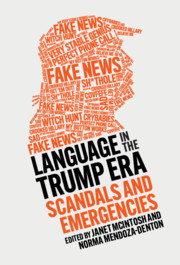Book contents
- Language in the Trump Era
- Language in the Trump Era
- Copyright page
- Dedication
- Contents
- Figures
- Tables
- Contributors
- Acknowledgments
- Note on Transcription Conventions
- Note on Ethnonyms and Phenotypic Descriptors
- Introduction: The Trump Era as a Linguistic Emergency
- Part I Dividing the American Public
- Part II Performance and Falsehood
- 5 Part II Introduction: The Show Must Go On: Hyperbole and Falsehood in Trump’s Performance
- 6 Trump’s Comedic Gestures as Political Weapon
- 7 45 as a Bullshit Artist: Straining for Charisma
- 8 Plausible Deniability
- Part III The Interactive Making of the Trumpian World
- Part IV Language, White Nationalism, and International Responses to Trump
- Index
- References
6 - Trump’s Comedic Gestures as Political Weapon
from Part II - Performance and Falsehood
Published online by Cambridge University Press: 18 September 2020
- Language in the Trump Era
- Language in the Trump Era
- Copyright page
- Dedication
- Contents
- Figures
- Tables
- Contributors
- Acknowledgments
- Note on Transcription Conventions
- Note on Ethnonyms and Phenotypic Descriptors
- Introduction: The Trump Era as a Linguistic Emergency
- Part I Dividing the American Public
- Part II Performance and Falsehood
- 5 Part II Introduction: The Show Must Go On: Hyperbole and Falsehood in Trump’s Performance
- 6 Trump’s Comedic Gestures as Political Weapon
- 7 45 as a Bullshit Artist: Straining for Charisma
- 8 Plausible Deniability
- Part III The Interactive Making of the Trumpian World
- Part IV Language, White Nationalism, and International Responses to Trump
- Index
- References
Summary
This chapter argues that the success of Trump’s candidacy in the 2016 Republican primary was due in part to its value as barbed comedic entertainment, generated through gesture. The chapter builds on semiotician Mikhael Bakhtin’s notion of the “grotesque body” to examine the ways that Trump’s unconventional communicative style, particularly his use of gesture to critique the political system and caricature his opponents, brought momentum to his campaign by creating spectacle. By reducing a target perceived as an opponent to an essentialized action of the body, Trump’s bodily parodies deliver the message that he rejects progressive social expectations regarding how minority groups should be represented. Five highly mediatized caricatures are analyzed in detail: the Wrist-Flailing Reporter, the Food-Shoveling Governor, the Choking Ex-Politician, the Border-Crossing Mexican, and the Swooning Democratic Nominee. In each of these gestural enactments, Trump displays his antagonism to political correctness by embodying discourses of disability, class, race, immigration, and gender, thus encouraging a new sociopolitical order that discourages empathy toward the vulnerable.
Keywords
- Type
- Chapter
- Information
- Language in the Trump EraScandals and Emergencies, pp. 97 - 123Publisher: Cambridge University PressPrint publication year: 2020
References
- 5
- Cited by

